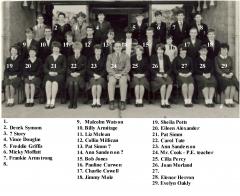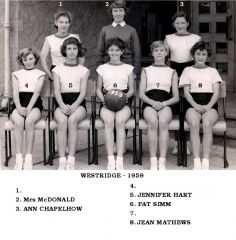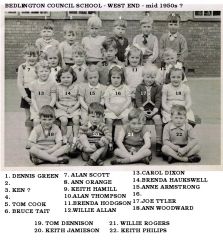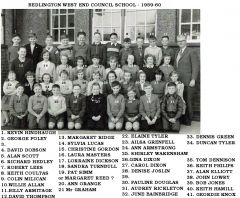
Jammy
Members-
Posts
121 -
Joined
-
Last visited
-
Days Won
14
Content Type
Forums
Gallery
Events
Shop
News
Audio Archive
Timeline
Everything posted by Jammy
-
Westridge 1962 MrCooks Class named
Jammy commented on Alan Edgar (Eggy1948)'s gallery image in Historic Bedlington
Canny Lass, there must have been 2 Pat Simms. I was in the same class at one time and she was heavy built. I know several people in her school photo and they were also in my class. The other one that I think you are referring to is slim and is the netball player. I don't recognise anyone in her school photo. No. 27 is Linda Spry -
On the lake named.jpg
Jammy commented on Alan Edgar (Eggy1948)'s gallery image in Historic Bedlington
-
1959 Netball Team named.jpg
Jammy commented on Alan Edgar (Eggy1948)'s gallery image in Historic Bedlington
-
Westridge 1962 MrCooks Class named
Jammy commented on Alan Edgar (Eggy1948)'s gallery image in Historic Bedlington
-
Alan, I know all the people you mention. You may know Norman Hills died in his early 50's I believe, with a heart problem as did Robin. Davey Bower is gone as is Mick Maguire. I grew up in the same street as Bob Pattison(big paddy). Bob's brother John was my mate and was also called paddy or padsa. Yes Alan Maguire is the oldest in the family. Dave Aisbitt was/is known as Dazzy. I think anyone around our age was known to us around the station. A radio program I listen to on Saturdays from 4 to 8pm is all 60's stuff so well worth a listen for us as kids growing up in the 60's. It's Gold radio and is on Sky channel 0121. It's also available as an app for phones and tablets and is available online. A google will find it very quickly. It brings back a lot of memories. Phones and tablets do not sound so good because of the poor speakers they have. It's on 24hrs a day when they have a mix of older music and often only an advert every 30 mins, so good. They may play 60's music from 10pm the rest of the week.
-
I struggled to find the Vesta photo but did finally find a match! I don't recognise her name from all those years ago. I thought Gordon would be a school year younger than you but I could be wrong. I went to school with Raymie and was my best school mate till those things that wore skirts took my interest. I spoke to Raymie at the coop at the end of last year. He still lives at the Havelock with Val. Robin Hills was in the scouts when I was a member. He was older than us. The last I knew he was living at Ellington before he died. Jammy
-
HIGH PIT WILMA There is another brother and a sister Winter. The brother is Gordon and is the next brother down from Dennis. I cannot remember the name of the sister. I think she was next to Gordon but not sure which side. She may have departed this world. I knew father Billy as well because he kept canaries as I did at one time. The youngest is Tommy. Geordie lives not far from Puddlers Row. He was also very strong like Billy yet father Billy was short and slightly made. The strength probably came from the mother. As far as I know none of the other brothers fancied a sewage swim! Yes building and rebuilding the stone dam was part of growing up. Jammy
-
Your DUCK IS DEAD A woman brought a very limp duck into a veterinary surgeon. As she laid her pet on the table, the vet pulled out his stethoscope and listened to the bird's chest. After a moment or two, the vet shook his head and sadly said, "I'm sorry, your duck, Cuddles, has passed away." The distressed woman wailed, "Are you sure?" "Yes, I am sure. Your duck is dead," replied the vet.. "How can you be so sure?" she protested.. "I mean you haven't done any testing on him or anything. He might just be in a coma or something." The vet rolled his eyes, turned around and left the room. He returned a few minutes later with a black Labrador Retriever. As the duck's owner looked on in amazement, the dog stood on his hind legs, put his front paws on the examination table and sniffed the duck from top to bottom. He then looked up at the vet with sad eyes and shook his head. The vet patted the dog on the head and took it out of the room. A few minutes later he returned with a cat. The cat jumped on the table and also delicately sniffed the bird from head to foot. The cat sat back on its haunches, shook its head, meowed softly and strolled out of the room. The vet looked at the woman and said, "I'm sorry, but as I said, this is most definitely, 100% certifiably, a dead duck." The vet turned to his computer terminal, hit a few keys and produced a bill, which he handed to the woman.. The duck's owner, still in shock, took the bill. "£1,500!" she cried,"£1,500 just to tell me my duck is dead!" The vet shrugged, "I'm sorry. If you had just taken my word for it, the bill would have been £20, but with the Lab Report and the Cat Scan, it's now £1,500.
- 1 reply
-
- 2
-

-

-
Yes Eggy, we almost certainly worked together on the dam construction. I do remember you as a youngun though not from school because our education paths never crossed. At the Grammar school you were in the same class as my cousin Michael at one time or maybe all the time. Does anyone remember Billy Winter swimming from the furnace bridge down stream to the black bridge(railway) on a full tide? There was a raw sewage outfall next to the furnace bridge so he swam through and with it downstream! His brother Geordie did it a couple of years later. I never heard anything but I bet they were both poorly afterwards with at least gut rot. We used to shoot the rats with our catapults at that outfall. After the sewage water was diverted from the outfall the worms we used for fishing at Granary Point were never as big. Jammy
-
Yes we did play down the woods a lot and swim in the river from the flat rock that we called the diver. We removed stones from the river bed in front of the diver to create a bit more depth and tried to form a dam with the stones. We did have some success with the dam so ended up with enough depth to dive in. Often we would find the dam was gone and couldn't understand why because it was quite well built and there hadn't been any floods to wash it a way. I found out in my 20's that the fishermen knocked it down because it prevented the sea trout from getting further up the river. We rebuilt the dam many, many times, gave us something to do cause we had no money. We also walked to Humford baths and back. There always seemed to be a lot of wasps there. Another thing we did was stab eels and flatties with a cutlery fork fastened to a stick. We all wore old shoes or sandshoes when plodging. One year the only xmas present I wanted was a pair of wellies so I could plodge when the water was cold! There was a swing or rather 2 up the ha'penny woods. We would often pedal there on our bikes whereas the lads and lasses from the south end of Bedlington would walk and wade across the river to get there. The rope swings were hung from a tree then pulled up the bank to the rock face where we would jump on and swing out into the space, One day when I was 13 I was on one of the swings and it snapped when out so I fell about 30'. This resulted in a broken wrist. It's still out of shape after Ashington hospital had 2 goes at fixing it. Fortunately it hasn't bothered me and I was not a pen pusher when I worked. Just turned 15yrs to 67yrs without a break except for holidays. Happy days and no fears of being abducted or molested. I don't remember anyone who experienced these things. At weekends and holidays we had to be home before dark. Often we were back sooner cause we were starving. Sea fishing from North Blyth staithes, the West Gears and the pier from 11 years old and only with my pals. We used to walk to Granary Point to dig worms for the fishing. We were like running dogs but very fit. No adults but we didn't need them, we had common sense because we were allowed to be out learning about the outside goings on when we were younger. The kids nowadays haven't got a clue of how outside things work. The big majority of them don't know what a starling is. We knew nearly every bird or animal we saw. I think we were born at the best time. I'm 71yrs soon so was young when I played at the back of Puddlers Row. I didn't know anyone who lived there. I remember the black and white films at both Bedlington and the Station Wallaw. Saturday matinees were when we went. Pearl and Dean were always on with the occasional cartoon before the main film. I remember the start of The Third Man had the hero(?) standing under a street lamp that I think was a lit gas lamp. They must have taken that opening sequence before you and your mates got there and pushed the lever!!! Take care, Jammy
-
Hi High Pit Wilma, I'm sure we would have done something similar to you with our local lamp but getting up the standard was a problem, we were not very tall at the time. I only remember the lamps going up and down Stead Lane and down the woods(furnace bank), no others. None were very bright but we could see the pavement close to them. I'm sure we could have hidden in the dark areas between them. Jammy
-
I found this photo of the railway station at the Station which does have a gas lamp on the platform that was the type, if not exactly, as those in Stead Lane.
-
The gas light heads in Stead Lane were 4 sided with a taper and were about 14" high. They were not ornate, just functional. The mantle was about twice the size of a Tilley lamp mantle. None of the ones you posted are like the Stead Lane type. The cast iron poles are similar though I'm fairly sure the bottom was square. I'll try a google for gas lights or lamps and see if I can find a similar one. The only sewer gas light I know of is on the footbridge over the river from Castle Square at Morpeth. I was told it only ran off the methane from the sewer pipes and no coal gas and later natural gas was involved. Eggy, your photo shows a sewer gas light using piped gas as well as methane. This may be the case at Morpeth because should there be a shortage of methane the light would go out. The Morpeth one burned 24hrs a day as you would expect to burn off the sewer gases. I'm sure the original light is still there but don't know if it is converted to electricity. Jammy
-
Hi all, I moved into the last house built in Tomlea Avenue at the age of 2.75yrs in May 1952. Puddlers row was there then and I played in the ruins up to the age of 5yrs. Then they were gone, probably gradually removed when I was at school. They were built of a very dark grey clinker that may have come from the brickworks. It wasn't slag from the Iron Works even though there were Iron Works employees living there originally. I don't know if the iron producing process produced anything else that could be used to build the houses. Prior to moving to Tomlea I lived in Moorland Ave with my grand parents. I remember going to see one of the first houses built in Grange park. It was a viewing house on the right at the start of the estate. That would have been late 1951 or early 1952. I also remember when living with my grand parents, looking through the bottom garden fence to see the sheep in the field so the estate wasn't built then. That would be early 1951. The Ariey(?) house parts were mainly made in factories and erected on site. There was a huge shortage of housing after WW2 so providing houses this way was quick and could be erected even when it was raining. There was a shortage of all building materials in Britain so that's why the house walls were reinforced cast cement panels. Another reason to build them like that was, with a shortage of skilled labour because so many tradesmen were killed in the war, they were like a meccano set to put together. I think Eggy mentioned about the schooling situation in the 50's. When I started school, Burnside, Kings and Queens road area and Grange Park were producing kids at a rapid rate. Even though Grange Park estate was still being built as soon as a pair of semi's were completed families moved in with their kids, or made some. The rules then were anybody living above the railway gates(west) could not go to the station infants because the places were taken by kids east of the gates. I couldn't go to the Whitley because of the kids coming out of the Haig and Beatty road, Millfield and the other estates in that area filled the seats so went I to the West End school, know as the Coonsil school to us and many then. Can anyone remember the gas lights running down Stead Lane? The was one which stood near Raisbecks down bus stop in front of Puddlers. I think they were on a clockwork timer but us, being kids, would kick the cast pole and the light would come on! If I think of anything else about Puddlers row I'll post it. Jammy
-
West End Junior School - Mid 50's
Jammy commented on Alan Edgar (Eggy1948)'s gallery image in Historic Bedlington
-
1961 Upper Sixth named.jpg
Jammy commented on Alan Edgar (Eggy1948)'s gallery image in Historic Bedlington
-
West End Council School 1959-60
Jammy commented on Alan Edgar (Eggy1948)'s gallery image in Historic Bedlington
-
West End Junior School - Mid 50's
Jammy commented on Alan Edgar (Eggy1948)'s gallery image in Historic Bedlington
-
Does Anyone Know Anything About The Glove Factory ?
Jammy replied to katie's topic in History Hollow
Don Hutton was a machine mechanic and took over the Glove Factory with a partner(not known to me). I can't remember if he was still a boss when it closed. Don is not in the photos. Sadly Don died a few years ago but his wife Irene still lives on Stakeford estate. Jammy -
-
Hello all, my first post. I read with interest about the Ha'penny woods. Having lived in Bedlington station all my life except for a years folly into Newbiggin I think I have something to add. I remember that Fergusons, the transport company had something to do with the Ha'penny woods, probably owned it at sometime. There was a Ferguson daughter whose name may have begun with an 'E' who either died young or inherited the woods, probably the former, and the woods were handed to the people of the community as a free amenity by her relatives. The woods still retained the Ha'penny woods title. I did seek and find the plaque which I did read when I was a lot younger but sadly weather has taken it's toll and cannot be read. I cannot remember what was inscribed on the plaque. I don't remember anything about a fox and a horse rider but that doesn't mean it's not correct, most likely is. Something I noticed when reaching the second half of the path before the barbed wire fence was what appears to me to be slag from the iron works as a surface of the path. This got me thinking, why is it there. The rock faces in that area appeared to have been worked at sometime so was the slag laid so the iron works could transport the limestone rock for the iron making process or as blocks to reinforce the banks upstream of the dam and water wheel that supplied power to the iron works. If I'm correct it wouldn't have been a single path because rock is heavy so was probably transported by cart on a much wider track rather than on the back of horses or mules. I will take a magnet to confirm it is slag on my next walk on the path. I think Doyles shop closed at the end of the 60's or early 70's. I used it 1,000's of times being brought up in Tomlea Ave. I remember a 3 or large 2 story house at the start of the free woods at the furnace bank end. I believe a family called Blackburn lived in one of the houses and were the last occupants before it was demolished. Something else that has me thinking. Which way were the completed steam engines moved from the works. I suppose they could have travelled towards the Kitty Brewster or beyond to flatter ground and joined the rail network in the Bates pit area. The furnace bridge is an arch but is flat on the top so the engines could be wheeled/dragged across it with teams of horses. Then there would be the problem of getting them up to the bank top. I doubt horses could pull them up but perhaps a stationary steam engine could pull them up but where would they go from there. There was a rail track from the iron works that ran along the edge of the river towards the black bridge. This track was paid for by the Iron Works and connected with the Barrington pit track that brought coal to the riverside for transfer onto barges. The iron works then had coal delivered directly to the works. I'm not sure if the trains went along that track because it was probably not a standard gauge track and was used to carry tubs of coal. The trains could have been loaded onto a barge though that would be risky and where would they be off loaded. I'm a bit puzzled. There is a stone block wall next to the furnace bridge which was probably reinforcing the land behind it and was used to tie up barges bringing supplies to the Iron Works or taking some of the other goods produced at the Iron Works. The Iron works also produced 100,000's of stamped nails that were transported all over the UK and the world. Further info on the Barrington Pit track. It originally ran only to Granery point staithes through Binnes farm. This could have been limiting for getting the coal away via ships because they will have needed a full tide or very close to it to get docked and then cast off so would have had a turn around time of 12hrs from high tide to high tide. There could be full coal trucks or tubs waiting to discharge their loads when the next ships were able to dock so inefficient. A branch line was brought to the area west of the black bridge where barges were tied up and then filled. They would also have to wait for a full tide but the coal wasn't waiting to be loaded because several barges could be docked at the same time. The stone block wall can be viewed from the south bank of the river. Also an arched underpass can be viewed in the same area. This is not very high which is why I don't think the steam engines left that way. Jammy








